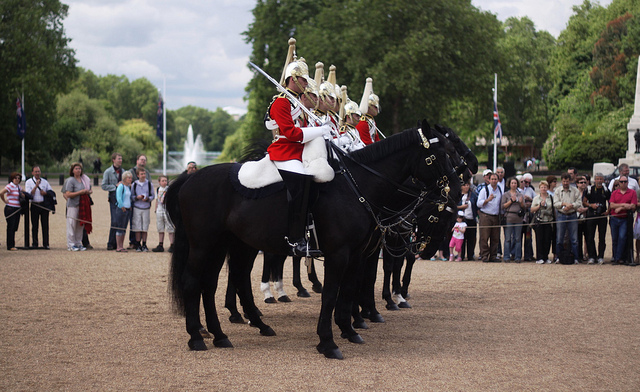Changing of the Guard
 Anyone interested in seeing a bit of British military pageantry during a visit to London should witness one or both of two shift-relief ceremonies:
Anyone interested in seeing a bit of British military pageantry during a visit to London should witness one or both of two shift-relief ceremonies:
The Changing of the Guard at Buckingham Palace and the Changing of the Queen’s Life Guard at Horse Guards Parade.
Changing of the Guard at Buckingham Palace
The more well-known of the two ceremonies, Buckingham’s Palace’s Changing of the Guard is held every day in the summer months, then every other day for the rest of the year. For exact dates, click here. The official ceremony lasts 45 minutes, from 11:15am to 12 noon.
The Foot Guards, who wear brass-buttoned red tunics and bearskin hats, are the Infantry regiments of the Queen’s Household Division; it’s their job to protect Her Majesty and the royal residences. A pair of Foot Guards are generally stationed in sentry boxes outside the Palace; when it is time to relieve this pair of their shifts, the New Guard marches to the Palace from Wellington Barracks with a Guards band (who play throughout the ceremony), while the Old Guard hands over and then returns to the Barracks themselves.
The Palace itself is only open to visitors during the late summer (click here for exact dates and times), when it features a lovely café with coffee drinks that sport an image of the Royal Crown in foam. From late April through much of October, all of November and some of December (click here for exact dates and times) you can head just around the corner and visit the Queen’s Gallery to see the Queen’s exquisite collection of Fabergé eggs and much more.
Buckingham Palace is triangulated between Green Park and St James’s Park. The closest Tubes are Victoria, Hyde Park and Green Park. Map
Changing of the Queen’s Life Guard
 Held for free each day at Horse Guards Parade, a large, fenced-in parade ground in front of the Whitehall entrance to St James’s Palace. Hours are Monday-Saturday at 11am and Sunday at 10am, and the ceremony takes 30 minutes.
Held for free each day at Horse Guards Parade, a large, fenced-in parade ground in front of the Whitehall entrance to St James’s Palace. Hours are Monday-Saturday at 11am and Sunday at 10am, and the ceremony takes 30 minutes.
Just like the Foot Guards, the Life Guard (the Cavalry regiments of the Household Division) are tasked with the protection of the Sovereign. Every day, twelve horse-mounted Life Guards are on duty at the Parade, and once a day, they’re relieved by a fresh lineup of guards. The New Guard arrives on horseback from the Hyde Park Barracks and lines up along the south side of the Parade, the Old Guard lines up to the north, and then they switch sides with precision.
While you’re by the Parade, be sure to visit the Household Calvary Museum, which explains the history of the Life Guard, displays a gorgeous collection of ceremonial uniforms, objects and memorabilia, and offers a glimpse into the working stables.
The Parade faces St James’s Park on its west side, and is bordered by the Old Admiralty and its Citadel (to the north), the Horse Guards Building (to the east) and the Foreign & Commonwealth Office (to the south).
Nearest tube stations are Charing Cross or Westminster, either enter Horse Guards from Whitehall or the St James’s Park side along Horse Guards Road. Map
Notes for both ceremonies
These events draw large crowds, and it’s advisable to not only arrive early to stake a claim for a good view, but to stay aware of your belongings at all times.
If the Queen is in residence at Buckingham Palace, there will be additional pomp and circumstance for each Changing of the Guard; the arriving new guard will be carrying Royal Standards (the queen’s official flag), with trumpeters from both sets of guards sounding the Royal Salute.
Photo credits: (Foot Guard) Cathy J, (Life Guard) Luke William Ellis